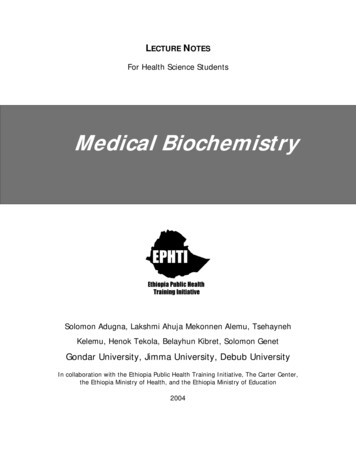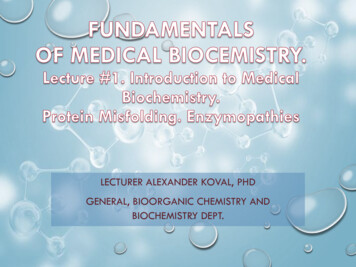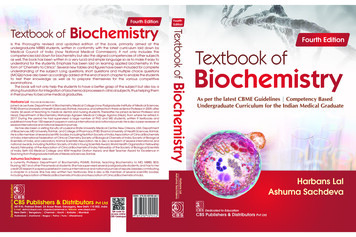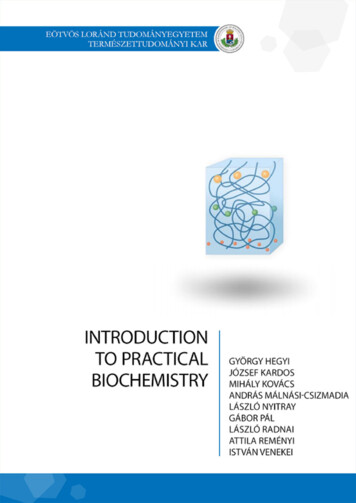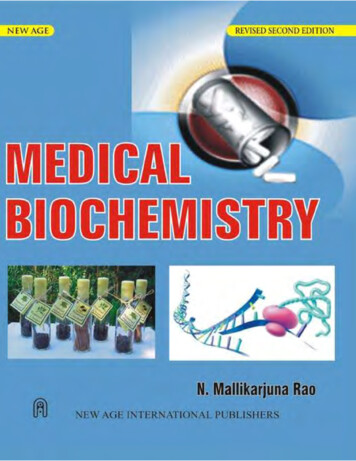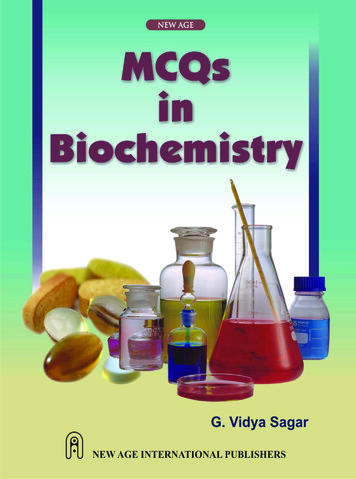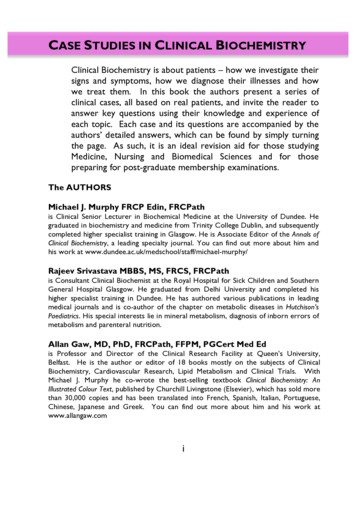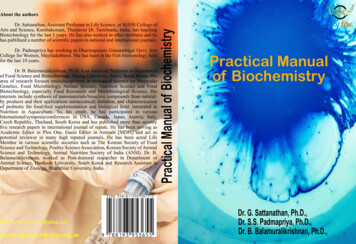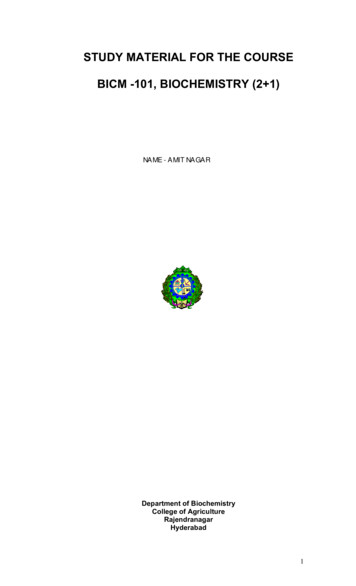
Transcription
STUDY MATERIAL FOR THE COURSEBICM -101, BIOCHEMISTRY (2 1)NAME - AMIT NAGARDepartment of BiochemistryCollege of AgricultureRajendranagarHyderabad1
Contributors for the preparation of study materialEditorDr(Mrs) S.SumathiProfessor & University HeadDepartment of BiochemistryCollege of AgricultureRajendranagarHyderabadS.NoName of the teacherNo of lecturesprepared1Mrs J.Aruna Kumari222Dr(Mrs) Nirmala Jyothi43Mr. Raghavendra14Dr. Sarkar52
INTRODUCTIONBiochemistry, as the name implies, is the chemistry of living organisms. Ithas its origin in chemistry and biology. It tries to explain life processes atmolecular level.There is a basic unity of biochemistry throughout nature.Although different organisms differ outwardly in their life processes, there arestriking similarities in executing different tasks. Genetic code, metabolicpathways, enzymes, coenzymes and even regulatory mechanisms are similar toa large extent in all the living organisms. Living organisms have certainextraordinary properties.They can grow, respond to stimuli and replicatethemselves with high fidelity. All these activities are ultimately interpretable inchemical terms. The lifeless organic molecules with appropriate complexity andproperties make a living thing. The basic phenomena of biochemistry are tounderstand how the collections of inanimate molecules that constitute livingorganisms interact with each other to maintain life. The basic life processes orchemistry remains broadly the same whether it is an unicellular microorganism orthe higher organisms such as human or plants. Life is nothing but thousands ofordered chemical reactions. In other words, chemistry is the logic of all biologicalphenomena.Biochemistry is taught to the students of agriculture, because1. Agriculture can be better managed with better varieties and practices.2. Transgenic plants which are high yielding, nutritionally more desirable andself fertilizing can be synthesized ie:- designer plants and animals3. Pesticides which are more specific, biodegradable and non toxic toanimals can be formulated.History of biochemistryOnly during 17th and 18th centuries, important foundations were laid inmany fields of biology.The 19th century observed the development of verycrucial concepts. Studies in biochemistry are so rapid that it is now a fore runnerand language of biology. Louis Pasteur, during 1857, did a great deal of work onfermentations and pointed out categorically the central importance of enzymes inthis process. The breakthrough in enzyme research and hence, biochemistrywas made in 1897 by Edward Buckner when he extracted enzyme from yeastcells in crude form which could ferment a sugar molecule into alcohol. This was afinal blow to vitalism. Wohler thus initiated the synthesis of organic compoundfrom inorganic compound. Neuberg introduced the term biochemistry in 1903.In 1926, James Sumner established the protein nature of enzyme. Hewas responsible for the isolation and crystallization of urease, which provided abreakthrough in studies of the properties of specific enzymes.3
In 20th century, the growth was very fast in the field of biochemistry. Fullstructures of many compounds were formulated for eg: ATP structure by Fiskeand Subbarow.The first metabolic pathway elucidated was the glycolyticpathway during the first half of the 20th century by Embden and Meyerhof. OttoWarburg, Cori and Parnas also made very important contributions relating toglycolytic pathway.1930-40.Krebs established the citric acid and urea cycles duringIn 1940, Lipmann described the central role of ATP in biologicalsystems.The biochemistry of nucleic acids entered into a phase of exponentialgrowth after the establishment of the structure of DNA in 1953 by Watson andCrick followed by the discovery of DNA polymerase by Kornberg in 1956. From1960 onwards, biochemistry plunged into an interdisciplinary phase sharing muchin common with biology and molecular genetics.Frederick Sanger’s contributions in the sequencing of protein in 1953 andnucleic acid in 1977 were responsible for further developments in the field ofprotein and nucleic acid research.Some important scientists and their contribution to biochemistry you study1828WohlerSynthesized the first organic compound, urea frominorganic components1854-Louis ganisms1877KuhneProposed the term ‘Enzyme’1894Emil FischerDemonstrated the specificity of enzymes and thelock and key relationship between enzyme andsubstrate1897BucknerDiscovered alcoholic fermentation in cell-free yeastextract1902Emil FischerDemonstrated that proteins are polypeptides1903NeubergFirst used the term ‘biochemistry’1913Michaelis andDeveloped kinetic theory of enzyme actionMenten1926SumnerFirst crystallized an enzyme, urease and proved it tobe a protein1933EmbdenDemonstrated crucial intermediates in the chemicalMeyerhof and pathway of glycolysis and fermentationParnas1937KrebsDiscovered citric acid cycle1940LipmannRole of ATP in biological systems1950Pauling andProposed the α-helix structure for keratinsCorey4
1950-ChargaffDiscovered the base composition of DNASanger andDetermined the complete amino acid sequence ofThompsoninsulin195319531953195819611999Watsonand delofsemiCrickstructureMeselson andConfirmedStahlconservative replication of DNAJacobthe& Proposed the operon hypothesis and postulated theMonodfunction of messenger RNAIngo potrykusGolden rice- rich in β-carotenePLANT CELLThe word cell was coined by Robert Hooke with the help of compoundmicroscope. Cell is the basic unit of life.A plant cell has three distinct regionsa. Cell wallb. Protoplasmc. VacuoleCell wall and vacuole are considered as non-living substances. Theprotoplasm which is living has two components1. Cytoplasm2. NucleusThe cytoplasm contains several organelles such as mitochondria, chloroplast,ribosomes, endoplasmic reticulum, golgi complex, lysosomes, plastids etc.5
Plant Cell & organellesThe brief description of the plant cell and various organelles and their functionsare as follows.Cell wall: Cell wall is a non-living component of the cell and is secreted andmaintained by the living portion of the cell, called protoplasm. A typical cell wall iscomposed of three different regions1. Middle Lamella2. Primary cell wall (1-3 μm thick and elastic)3. Secondary cell wall (5-10 μm thick and rigid)Functions of cell wall1. It protects the inner contents of the cell.2. It gives definite shape to the cell.3. It provides mechanical support to the tissues and act as a skeletalframework of plants.4. It helps in transport of substances between two cells.5. The cell wall is hydrophilic in nature and it imbibes water and helps in themovement of water and solutes towards protoplasm. It also acts as apermeable structure during absorption of minerals and solutes.Protoplasm: It is the living, colloidal and semi fluid substance. It is also called ascytoplasm. Cell devoid of cellwall is called protoplast. Protoplast is enclosed by amembrane called as cell membrane or plasma membraneCell membrane : All cells are enclosed by a thin, membrane called plasmamembrane or plasmalemma. The plasma membrane and sub cellular membraneare collectively called biological membrane.Cell membrane consists of proteins, lipids and other substances1. Proteins:- The proteins present in the membranes can be categorized intotwo typesa. Intrinsic proteins or integral proteins: - Which are embedded or buried inthe lipid layer. These proteins associate with hydrophobic interactions tothe tails or fatty acid chains of the lipid layer. In addition to the hydrophobicassociations, integral proteins also posses hydrophilic aminoacid residueswhich are exposed at the surface of the membrane. These proteins cannotbe removed easily.b. Extrinsic proteins or peripheral proteins: - They are attached to themembrane surface by weak ionic interactions. These proteins are notmuch involved in the architecture of membrane. Peripheral proteins arebound to hydrophilic proteins of the integral proteins protruding from thelipid layer.2. Lipids: - The cell membrane consists of phospholipids and glycolipids.The fatty acid chains in phospholipids and glycolipids usually contain 1620 even numbered carbon atoms. Fatty acids may be saturated orunsaturated.3. Other substances like polysaccharide, salicylic acid etc. are foundattached to the proteins or lipids on the membrane.Functions of cell membrane:1. The cell membrane surrounds the protoplasm of the cell, thus separatingthe intracellular components from the extracellular environment.2. It anchors the cytoskeleton to provide shape to the cell, and in attachmentto the extracellular matrix.3. The plasma membrane is differentially permeable and able to regulate thetransport across the membrane.4. The cell membranes maintain the cell potential.6
Cell nucleus:It is oval or spherical in shape and is generally larger in active cells than inresting cells. A nucleus consists of three main parts viz. nuclear envelope,nucleolus and chromatin. The nucleus is separated from the cytoplasm by adouble membrane called the nuclear envelope. The space between the outer andinner membrane is known as nuclear pores which provide direct connectionbetween nucleus and cytoplasm.Nucleolus is a spherical, colloidal body found in the nucleus and is theplace where almost all DNA replication and RNA synthesis occur.Chromatin is the basic unit of chromosome and contains genes which playimportant role in the inheritance of characters to offspring from parents.Functions of cell nucleus :1. It regulates growth and reproduction of cells.2. The nuclear envelope allows the nucleus to control its contents, andseparate them from the rest of the cytoplasm where necessary.3. The DNA replication, transcription and post transcriptional modificationoccur in the nucleus.Chloroplast : Chloroplasts are organelles found in plant cells and other eukaryoticorganisms that perform photosynthesis because of the presence of greenpigment, chlorphyll. They are flattened discs usually 2-10 micrometers indiameter and 1 micrometer thick. The chloroplast is surrounded by doublelayered membrane. The space between these two layers is called intermembranespace. Stroma is the aqueous fluid found inside the chloroplast. The stromacontains the machinery required for carbon fixation, circular DNA, ribosomes etc.within the stroma the stacks of thylakoids are arranged as stacks called grana. Athylakoid has a flattened disc shape and has a lumen or thylakoid space. Thelight reactions occur on the thylakoid membrane.Functions of chloroplast :1. The important processes of photosynthesis i.e, light and dark reactionsoccur within the chloroplast.2. The granum is the site of NADP reduction forming NADPH H andphotophosphorylation i.e., formation of ATP in presence of light. Thus,light reaction of photosynthesis takes place in the granum region.3. The stroma is the main site for the dark reaction of photosynthesis.4. The chloroplast has its own genetic system and is self replicating. Thus,associated with cytoplasmic inheritance.Mitochondria : Mitochondria are rod shaped cytoplasmic organelles, which aremain sites of cellular respiration. Hence, they are referred to as power house ofthe cell. Each mitochondrion is enclosed by two concentric unit membranescomprising of an outer membrane and an inner membrane. The space betweenthe two membranes is called perimitochondrial space. The inner membrane hasa series of infoldings known as cristae. The inner space enclosed by cristae isfilled by a relatively dense material known as matrix. The matrix is generallyhomogeneous, but may rarely show finely filamentous or fibrous structures. Thematrix contains several copies of round or circular DNA molecules.Functions of mitochondria:1. ATP, the readily available form of energy is produced in mitochondria.2. Krebs cycle takes place in the matrix of mitochondria3. The enzymes of electron transport chain are found in the inner membraneor cristae of mitochondria.4. Heme synthesis occurs in mitochondria.5. Controls the cytoplasmic Ca 2 concentration7
Ribosomes : Chemically, ribosomes are ribonucloprotein complexes. Ribosomesare of two types. Ribosomes of prokaryotes have sedimentation coefficient of 70S and consist of two sub units of unequal sizes 50S and 30 S subunits.Ribosomes of eukaryotes have 80 S sedimentation coefficient (40S & 60 S). Thetwo or more ribosomes become connected by a single m RNA and then may becalled polyribosomeThe major function of the smaller subunit of ribosome is to provide propersite for binding of mRNA and its translation. The larger subunit of ribosomesupports translation and translocation processes coupled with polypeptidesynthesis.Functions of Ribosomes :1. They provide the platform for protein synthesis2. They have the machinery for protein synthesis.Golgi complex: Golgi bodies is an assemblage of flat lying cisternae one abovethe other in close parallel array. Each golgi complex has 3 to 12 interconnectedcisternae which are composed of lipoproteins.Functions of Golgi complex:1. It helps in Packaging of proteins for exporting them.2. It plays a role in sorting of proteins for incorporation into organelles.3. It is involved in the formation of the cell wall of plant cellsEndoplasmic reticulum: Endoplasmic reticulum arises from the outer membraneof the nucleus forming an intermediate meshed network. It is of two types. Thegranular or rough endoplasmic reticulum in which the outer surface ofendoplasmic reticulum is studded with ribosome and agranular or smoothendoplasmic reticulum in which the ribosomes are not attached.Functions of Endoplasmic reticulum :1. Rough endoplasmic reticulum is associated with the synthesis of proteins.2. Smooth endoplasmic reticulum is associated with synthesis of lipids andglycogen.3. It acts as an inter-cellular transport system for various substances.4. It contains many enzymes which perform various synthetic and metabolicactivities.Vacuole: It is a membrane bound organelle found in plant cell and occupiesmost of the area in the plant cell. A vacuole is surrounded by a membrane calledtonoplast. It is an enclosed compartment filled with water containing inorganicand organic molecules including enzymes in solution.Functions of vacuole:1. Isolating materials that might be harmful or a threat to the cell.2. Stores waste products.3. Maintains internal hydrostatic pressure or turgor within the cell4. Maintains an acidic internal pH5. Exports unwanted substances from the cell6. Allows plants to support structures such as leaves and flowers due to thepressure of the central vacuole.7. Most plants stores chemicals in the vacuole that react with chemicals inthe cytosol.8. In seeds, stored proteins needed for germination are kept in protein bodieswhich are modified vacuole.Microbodies : Microbodies are ubiquitous organelles found in the majority ofeukaryotic plant cells. They are mostly spherical and have a diameter ranging8
from 0.2um to 1.5um. Two types of microbodies, peroxisomes and glyoxysomes,have been characterized. These organelles differ in their distribution and enzymecomposition, although both have the capacity to transform non-carbohydratematerial into carbohydrate.Peroxisomes : Peroxisomes are found in leaves of higher plants.Functions of Peroxisomes: Peroxisomes act in parallel with chloroplast in higherplants and are believed to undertake photorespiration.Glyoxysomes : Glyoxysomes are temporary in that they occur during transientperiods in the life cycle of a plant such as in certain beans and nuts which storefats in their seeds as energy reserves. Glyoxysomes appear in the first few daysafter seed germination in endosperm cells and associate closely with lipid bodies.They disappear after the storage fats are broken down and converted intocarbohydrate.Functions of Glroxysomes: Glyoxysomes are involved in the formation of sugarsby the breakdown of fatty acids in germinating seeds.Cytoskeleton : The cytoskeleton is scaffolding contained within the cytoplasmand is made out of protein. The cytoskeleton is present in all cells. Thecytoskeleton provides the cell with structure and shapeThere are three main kinds of cytoskeleton filaments1. Microfilament: - They are composed of actin subunits.2. Intermediary filaments: - They function in the maintenance of cell shape bybearing tension. They also participate in the cell-cell and cell matrixjunctions.3. Microtubules: - They are like hollow cylinders mostly comprising of 13protofilaments which in turn are alpha and beta tubulin. They arecommonly organized by the centrosome.Functions of cytoskeleton :1. Provides mechanical support2. Anchors organelles3. Helps to move substances intra cellularPLANT CELL WALLPlant cells are surrounded by a rigid, semi-permeable cell wall. The cell wall iscomprised of mainly polysaccharides with some proteins and lipids. The threemain polysaccharide components of the cell wall are cellulose, hemicellulosesand pectin. Two types of proteins like expansin and extensin are presentpredominantly. Since cell wall also contains enzymes, it can be regarded as anorganelle. Cell walls provide rigidity and mechanical strength, maintain cellshape and the direction of cell growth. The cell wall also prevents expansionwhen water enters the cell. Under the light microscope the walls separating thecells in a plant tissue are usually clearly visible. The walls of adjacent cells meetat a dividing line known as the middle lamella, which can be distinguished withthe electron microscope.Each cell wall performs certain specialized functions, such as1. Structural function.2. Affects developmental pattern9
3.4.5.6.7.Defines cell’s position within the plantCell- cell and cell- nucleus communicationDefense against pathogensRecognises symbiotic nitrogen fixing bacteriaRecognises selfCell wall is made up of three layers. They area) Middle lamella: This is the first layer formed during cell division. It makes upthe outer wall of the cell. It is shared by adjacent cells. It is composed mainly ofpectic compounds and proteinsb) Primary wall: Primary wall deposited by cells before and during active growth.Plant cells are surrounded by a polysaccharide rich primary wall. The primarywalls of different plant cells differ greatly in appearance. Young cells have a verythin cell wall.Composition of primary wallPrimary walls are composed predominantly of polysaccharides together withlesser amounts of structural glycoproteins, phenolic esters, enzymes, andcalcium and boron mineralsFunctions of primary wall: It gives structural and mechanical supportIt maintains and determines cell shapeIt resists internal turgor pressure of cellControls rate and direction of growthUltimately responsible for plant architecture and formRegulate diffusion of material through the apoplastProtects against pathogensProtects against dehydration and other environmental factorsSource of biologically active signaling moleculesPlays a major role in cell – cell interactionParticipates in early recognition of symbiotic nitrogen fixing bacteria.c) Secondary cell wall: Secondary cell wall is formed after cell enlargement iscompleted. Some cells deposit additional layers inside the primary wall. Thisoccurs after growth stops or when the cells begin to differentiate (specializes).The secondary wall is mainly for support and is comprised primarily of cellulose,hemicellulose and lignin. It often can distinguish distinct layers, S1, S2 and S3 which differ in the orientation, or direction, of the cellulose microfibrils. It isextremely rigid and provides compression strength.Composition of secondary cell wallThe secondary cell walls are much thicker than the primary walls and consist of40-45% cellulose, 15 – 35 % hemicellulose, 15 – 30 % lignin and negligibleamounts of pectic polysaccharides.Functions of secondary cell wall: It plays major role in providing mechanical support. It facilitates the transport of water and nutrients. It allows extensive upright growthFormation of cell wallA cell plate formed between the two daughter cells originates from microtubles,which act as the base for the construction of the new cell wall. The microtubulesmay direct the cell- wall forming materials to the cell plate which grows from thecentre towards periphery of the cell and soon becomes the pectin rich middle10
lamella. Above the middle lamella the primary wall formation takes place. Theprotoplasts of the cells of the primary wall secrete the secondary wall materials,when the cells have stopped enlarging. The protoplast then totally diminishes andonly the wall remains. The rings, spirals or network in a mature stem crosssection are due to secondary wall deposition.Chemical changes in cell wallChemical changes take place in cell wall by accumulation of various depositionsas the cell matures. These chemical changes bring corresponding change in thestructure and function of the cell. The various depositions areLignification: The deposition of the lignin on cell walls is called lignification. As aresult of lignification, the cell walls become hard, thick walled and dead. Usuallyafter of the thickening of the cell wall, the protoplasm of the cell diminishes in sizeand the cell becomes dead and rigid. Cellulose microfibrils are impregnated inphenoloic polymer called lignin. Lignin displaces water in matrix and formhydrophobic meshwork that bonds tightly to cellulose and prevent wallenlargement. Lignins add up mechanical strength and reduce susceptibility ofwall to attack by pathogensSuberization: The cell wall of cork cells and casparian strips of endodermis getdeposited with a layer of suberin by a process known as suberization.Cutinization: In some cells, in the outer layers of the cell wall, the cellulose getsconverted to cutin by a processs of cutinization. This forms a definite,impermeable membrane on the cell wall of cuticle. Cutinization helps in checkingevaporation of water. It is found normally on the exposed parts of the plant.Mucilaginous changes: Sometimes the cellulose is changed to mucilage whichhas the property of absorbing and retaining water. This forms a viscous,mucilaginous coating on the cell walls and helps to tide ove dry conditions. Manysea weeds yield mucilaginous substances such as agar, alginic acid andcarageenen of great commercial value.Mineralization: The deposition of the minerals on the cell walls by the process ofinfilteration or by deposition of inorganic salts is known as mineralization. Theminerals usually deposited are silica, carbonates and oxalates of calcium. Thephenomenon of silica and calcium deposition are known as silicification andcalcification respectively.Role of plant cell wall in live stock, food and paper industry: Primary walls are the major textural component of plant-derivedfoods. Plant-derived beverages often contain significant amounts of wallpolysaccharides. Some wall polysaccharides bind heavy metals,stimulate the immune system or regulate serum cholesterol. Wall polysaccharides are used commercially as gums, gels, and stabilizers. Cell wall structure and organization is of interest to the plantscientist, the food processing industry and the nutritionist. Cellulose plays a major role in paper industry. Secondary walls also have a major impact on human life, as theyare a major component of wood It is a source of nutrition for livestock. The cell walls of fruits and vegetables are now recognized asimportant dietary components and may protect against cancer ofcolon, coronary heart disease, diabetes, and other ailments.11
Nevertheless, numerous technical challenges must be overcome toenable the efficient utilization of secondary walls for energyproduction and for agriculture. Composition of cell wall12
Layers of cell wall13
PROTEINSProteins are made up of different amino acids.Amino acids: In amino acids, there are two functional groups: an amino groupand a carboxylic group. Both these groups are attached to the α carbon atomonly. Amino acids are alpha (α) amino carboxylic acids. The carbon atom istetrahedral in shape. The various groups attached to it are placed in differentpositions. Since the valence of the carbon atom is four, four groups can beattached to the carbon atom. Based on the groups attached to the carbon atom itmay be of two types.1. Symmetric carbon atom: When the valence of the carbon is satisfied bymore than one similar atoms/ groups then the particular carbon atom is calledas symmetric carbon atom. Eg : GlycineCompounds containing symmetric carbon atoms are optically inactive since theycannot rotate the plane of polarized light.2. Asymmetric carbon atom: When the valence of the carbon is satisfied by fourdifferent groups, then that particular carbon atom is called as asymmetric carbonatom.Eg: AlanineIn amino acids, to α carbon atom, an amino group, a carboxylic groupand a hydrogen atom are attached and the fourth group is the R group. This Rgroup varies for each amino acid. All amino acids except glycine have at leastone asymmetric carbon atom, hence they are optically active.Classification of amino acids: Amino acids can be classified in variousways.1. Based on side chains: Based on the structure of the R groups, all theamino acids are classified as aliphatic, aromatic and heterocyclic amino acids.Structure of amino acidsName oftheaminoacid3lettercodeStructureUnique featureALIPHATIC R GROUP CONTAINING HYDROPHOBIC AMINO ACIDSGlycineAlanineGlyAlasymmetric aminoacid, opticallyinactive amino acidAliphatichydrophobicneutral.14
c,hydrophobicneutral, branchedchain R groupcontaining aminoacid.Aliphatic,hydrophobicneutral, branchedchain R groupcontaining aminoacid.Aliphatic,hydrophobicneutral, branchedchain R groupcontaining aminoacid.Hydrophobic,neutral, imino aminoacid.ALIPHATIC R GROUP CONTAINING HYDROPHILIC,POSTIVELY CHARGED AMINO ACIDSHistidineLysineArginineHisAromatic, polar,hydrophilic, vecharged, imidazolegroup containingamino acidLysPolar, hydrophilic,charged ( ), ε aminogroup containingdiamide amino acidArgPolar, hydrophiliccharged ( ), guanidogroup containingamino acidALIPHATIC R GROUP CONTAINING HYDROPHILIC,15
NEGATIVELY CHARGED AMINO ACIDSPolar,hydrophilic- ve charged Rgroupcontainingamino acidGlutamaticacidAspartaticacidGluAspα , γ dicarboxylicacidPolar, hydrophilic- ve charged Rgroup containgamino acids .α ,β dicarboxylicacidALIPHATIC R GROUP CONTAINING HYDROPHILIC NEUTRALAMINO philicneutralIt is a ydrophobicneutralHydrophobicneutral,sulphur containingamino acid.16
PolarhydrophilicneutralSerineSerAROMATIC R GROUP CONTAINING AMINO utral, indole groupcontaining aminoacidAromaticpolarhydrophobicphenol groupcontaining aminoacid.Aromatichydrophobicneutral amino acidPhenylalaninePhe2.Based on their presence or absence in proteins: Amino acids are classifiedas protein amino acids and non protein amino acids.a) Protein amino acids: - Amino acids that are used for synthesis of proteinsare called protein amino acids. All the above mentioned 20 amino acids arepresent in proteins.b) Non protein amino acids: Apart from the 20 amino acids that are present inproteins, several non protein amino acids are also present in nature. Theseare obtained by slight modification of 20 protein amino acids.Eg:- beta alanine, hydroxy proline, N- acetyl glutamic acid etc3. Based on requirement to the body as essential and non essential: Animalscannot synthesis all the 20 amino acids that are present in proteins. Somehave to be provided to the body through external diet. The amino acids whichcannot be synthesized by the body, which have to be supplied through diet arecalled essential amino acids. On the other hand, some amino acids can besynthesized by the body, and they are called as non essential amino acids.17
Essential amino oleucineLeucinePhenylalanineLysineHistidineis essential forchildren onlyNon essential amino acidsAlanineAsparatic acidGlutamatic acidCysteineGlycineProlineSerineTyrosine4. Based on polarity of the side chains: This is the most accepted form ofclassification of amino acids which is based on polarity and hydrophobicnature of R groups.a) Nonpolar or hydrophobic: The R groups of these amino acids are less solublein water, or hydrophobic, than those of polar, because they contain bulky sidechains. These amino acids play a major role in promoting hydrophobicinteractions within protein structures. Eg: Glycine, Alanine, Valine, Leucine,Isoleucine, Proline. Phenylalanine, Tyrosine and Tryptophan.b) Polar uncharged amino acids: The R groups of these amino acids are moresoluble in water, or hydrophilic, than those of non polar, because they containfunctional groups that form hydrogen bonds with water. These amino acidspossess oxygen, sulfur and/or nitrogen in the side chain and are therefore polar.The R group of these amino acids cannot be ionised and thus do not carry anoverall charge. These amino acids readily interact with water. Eg: Cysteine,Methionine, Serine, Threonine, Asparagine and Glutaminec) Polar amino acids with positively charged side chains: The R groups of theseamino acids are not only polar but they also carry a positive charge and aretherefore highly hydrophilic. Eg: Lysine, Histidine and Arginine. They are alsocalled as basic amino acids as they can easily accept a proton.d) Polar amino acids with negatively charged side groups: The R group of theseamino acids is not only polar but they also carry a negative charge. Eg : Asparticacid and Glutamic acid. They are also called as acidic amino acids as they caneasily donate a proton.Reactions of amino acids1.Ninhydrin test: Ninhydri
Biochemistry, as the name implies, is the chemistry of living organisms. It has its origin in chemistry and biology. It tries to explain life processes at molecular level. There is a basic unity of biochemistry throughout nature. Although different orga
